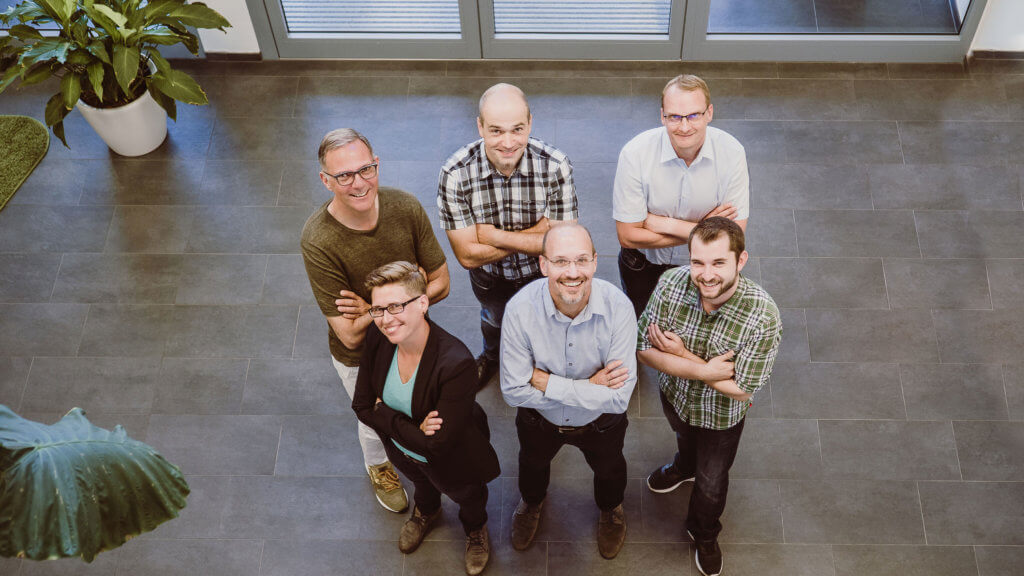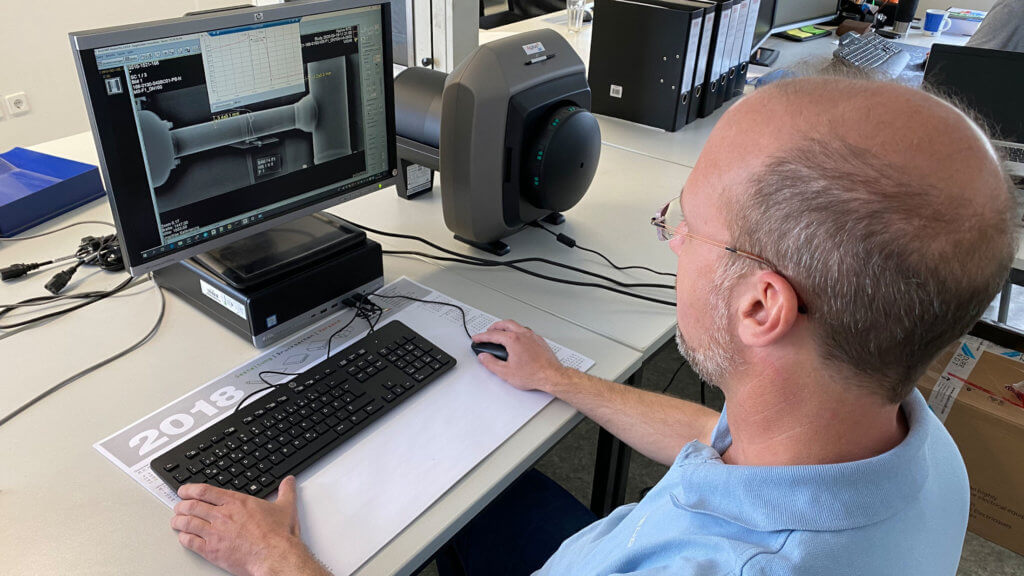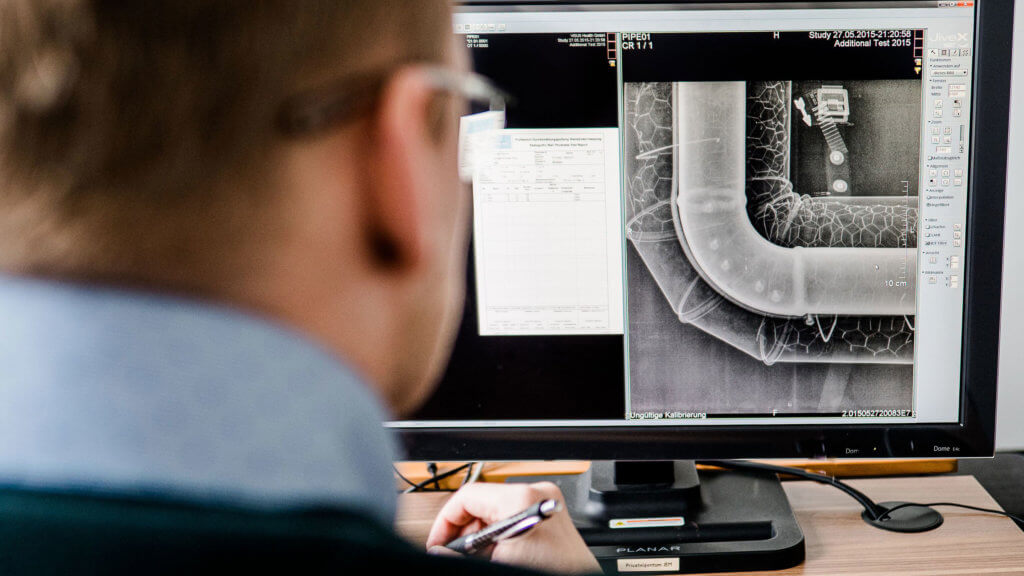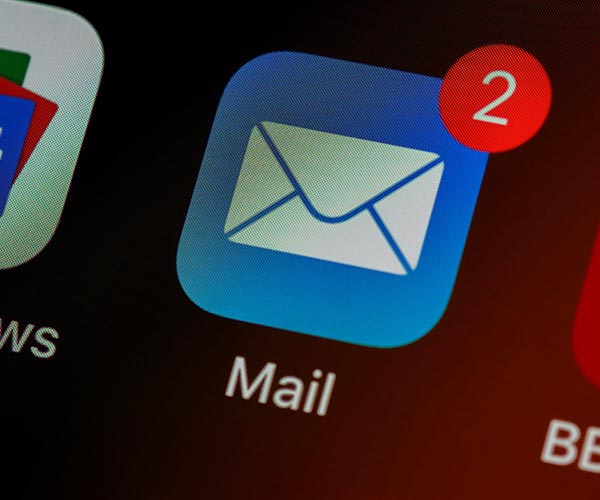The superpower of 'X-ray vision' - inspect systems digitally instead of analog
Ronja Schrimpf
When it comes to IT solutions and standards in the field of digital imaging and communication, the industry lags decades behind the medical sector. This is because a standard that evaluates and communicates image data quickly and accurately, independent of manufacturers, has become established in the healthcare sector: The DICOM standard. In industry, the search for efficient IT solutions is only gradually beginning - with the inspection image management system JiveX NDT, the startup VISUS Industry IT GmbH offers an answer to this search. In an interview with 5-HT, co-founder and managing director Peter Rosiepen reveals the possibilities offered by such an efficient view of an industrial plant.
 VISUS Industry IT Team
VISUS Industry IT TeamTracing the success story of medicine in industry
"It all started with VISUS Health IT GmbH, a company in the health care sector that takes care of people's diagnostics. In medicine there is an IT standard called DICOM - Digital Imaging and Communication in Medicine - which is internationally recognized. No device or IT solution is sold in the healthcare sector that is not DICOM-capable, because the users - i.e. the doctors - have insisted on having a manufacturer-independent file format to exchange, evaluate and archive data in the long term. For such requirements we need an IT standard and not proprietary data from different manufacturers.
This standard has now been around for 20 years and VISUS Health IT is the company in Germany that knows about DICOM. In 2015 we found out by chance that the industry has adopted this standard for the non-destructive testing of equipment and components and calls it DICONDE or Digital Imaging and Communication in Non Destructive Evalution. But when it comes to IT solutions, the industry is ten years behind medicine. For us this was the reason to say: 'We have a lot of experience with the standard that the industry lacks, so let's go back to the VISUS Health success story in the industry'".
"One could say: Even in the industry 'x-rays' are taken."
"In principle, we are open to all branches of industry, but the process industry, from oil and gas to the chemical and pharmaceutical industries, is particularly interesting for us. Because these industries work a lot with steam and pressure and have safety systems everywhere that have to be constantly checked. These tests are just as non-destructive as those in medicine - whether I test a person or a plant component non-destructively is the same in terms of the sequence of events, even if the testing technologies differ. In the chemical industry, for example, pipelines are checked for erosion and corrosion using radiography.
Our customers have about 30,000 measuring points per year, which they inspect by means of radiography, so-called shadow photography. A lot of energy is needed to get through the material. In addition, electricity is prohibited in chemical plants because of the danger of explosion. For these reasons, the chemical industry uses gamma rays instead of X-rays. In principle, however, the shadow image is exactly like the X-ray image in medicine. You could say: "X-rays are also used in industry".
Digitizing the 'X-ray view
"Every chemical plant has a leading system, usually an SAP. All plant components and usually also the test plans are stored in it. Each plant also has an inspection department that carries out the test orders. So far, it does this by means of a gamma emitter and an X-ray film, as you might remember from the radiologist's days. So for each exposure, the inspection department has to develop the film, analyze it in the light box and evaluate the condition of the tube based on the X-ray image. Then an inspection report is written - usually also on paper - and returned to the inspection manager, who enters the values into the leading system. So far, there is no digital procedure in the industry for the inspection.
This is exactly the process we are hooked into: We have an interface to the leading (SAP) system, pick up the orders there digitally and then send them to the radiographic system - which is also digital and generates digital inspection images. This means that no one has to type the orders into the device anymore, because the device already has all the data and can 'marry' them directly to the radiation image".
 Data is available digitally with VISUS Industry IT and can be further processed
Data is available digitally with VISUS Industry IT and can be further processedDeveloping the 'X-ray vision' into a superpower
"We also have tools for digital evaluation of the images, for example various image filters, magnifications and automatic wall thickness measurements - this is particularly important because the top edge of the tube is over-irradiated with gamma rays during irradiation. The upper edge is therefore not visible on the image. Up to now, the overradiation on the analog image has been scraped off with a razor knife by human hands. However, a computer can do this much better and more accurately because it can detect the upper and lower edges of the tubes with an algorithm.
This means that we measure the pipe walls much more accurately than a human being could. This is of course particularly important when it comes to predictive maintenance. Moreover, this technology, i.e. non-destructive testing, is the only way to get a look inside the plant while it is running.
 Precise measurement with VISUS Industry IT
Precise measurement with VISUS Industry ITThe analog pictures that were taken of the systems in the past are rarely looked at again. Made once, evaluated once and then taken away. We, on the other hand, digitize the images in the DICONDE standard - so the customer is not bound to us - and thus make it possible to continue using them. For example, to teach artificial intelligence, for which the DICONDE standard is ideal.
So VISUS Industry IT provides the digital view into the plant, wherever you want it, standardizes the data and can also make it available to artificial intelligence to answer the questions of the chemical industry in the future".
Exploiting all the advantages of 'X-ray vision'
"The entire test sequence is therefore digital, DICONDE-compliant and thus internationally standardized, audit-proof and structured for evaluation. The inspector gets better measured values because the measurements are more accurate than in the analog procedure.
We also have a proof of content for a digital assistant in which we checked weld seams that also have to be 'X-rayed'. With our digital welding seam assistant we cannot replace the inspector, but we can support him. We were able to achieve a defect detection rate of 99.59996 percent. A person who does this work every day and evaluates welds for two to three hours in a row achieves a defect detection rate of just 60 to 70 percent.
In addition, evaluation is three times faster in the digital process, as the images are already assigned to the correct system parts and can be stored digitally with ease. This also means that the inspection process as a whole is less prone to errors. And the servers for the digital images are cheaper than the archive rooms that were previously required for the analog 'X-ray images'.
With the push of a button you can also compare the pictures of the tests of the last years. In this way you can observe how the pipe has developed over the past years, whether it needs to be replaced or not. The view into the plant is immensely valuable".
How the 'X-ray view' came to industry
„Jens Martin and I have founded VISUS Industry IT 2018. We wanted to further develop the VISUS Health IT system especially for the industry. Jens Martin is so to speak our CTO, technician and developer, I am so to speak the CEO and come from sales. We have an unusual starting position for a startup because we already have a finished product. Since we spun off from VISUS Health IT, we already had a ready-for-sale product that we adapted and developed further for the industry. Currently, for example, Applus RTD, one of the world's largest service providers for testing, uses our product in the Shell Rheinland refinery, at BP in Gelsenkirchen and Lingen. But RWE and Fraunhofer are also among our clients. In addition, BASF has also already expressed interest in our product.
We have three investors, including High-Tech Gründerfonds HGTF, through which we also got to know 5-HT, NRW-Bank and Gründerfonds Ruhr. At the moment we are mainly looking for customers in the process industry".
The superpower of 'X-ray vision' is unrivalled
"I was surprised by the industry's attitude towards non-destructive testing and especially its value. But that is exactly what is changing. This is a situation that I am still familiar with from the year 2000 in medicine. At that time there was the change from analog to digital X-ray and I had the same experience with VISUS Health IT as I have today with VISUS Industry IT.
The crucial thing is to pick up the people. It works well if you try out the digital process with people for a day and help them. That's why we also offer on-site training and online seminars where we show the software, answer questions and give people the opportunity to get to know the digital process. For those interested, we also offer a test situation in which we install the entire software, connect all devices, offer training for all employees and integrate all components for one month - but for the time being, the customer only has to pay for our services. After one month he can then decide whether he wants to keep our software or not.
In the next two years, we want to be - or remain - market leader in Germany, because there is currently no other supplier for what we offer. Of course there are companies that have a partial solution, for example the equipment manufacturers themselves. But they never cover the entire test sequence and they are not - and this is decisive - manufacturer-independent, as is the DICONDE standard that we use".
5-HT Chemistry & Health Newsletter
Want the latest tech and industry news, events, relevant info from the ecosystem and more?
Subscribe to 5-HT Newsletter now Subscribe to 5-HT Newsletter now
Become part of the 5-HT Chemistry & Health
Exchange ideas with innovative startups and future-oriented companies in our ecosystem. We look forward to meeting you!